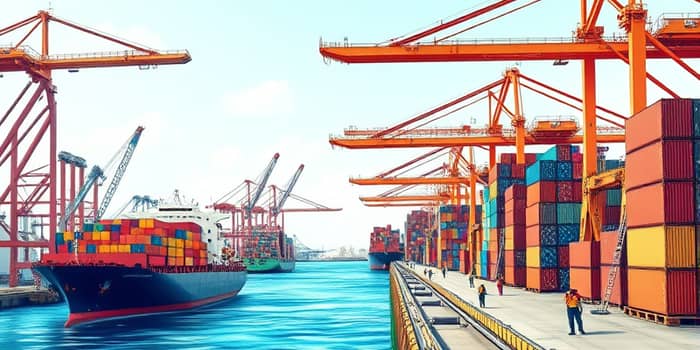
Amid the incessant ebb and flow of global commerce, a significant transformation is quietly unfolding at the world’s major seaports. For much of the past year, vessels queued for days offshore, cargo owners braced for spiraling costs, and consumers felt the pinch of empty shelves. Today, as we stand on the brink of a new logistical era, these scenes are giving way to smoother dock operations and renewed confidence in maritime lifelines.
This article delves into the factors that sparked the crisis, the tangible signs of recovery, and the actionable strategies businesses and policymakers can adopt to fortify supply chains against future upheaval. By weaving together data, expert insights, and practical guidance, our goal is to inspire readers to navigate complex challenges with clarity and resilience.
Beyond the numbers, everyday consumers witness the change through faster deliveries and stable pricing. Small businesses and exporters, once forced to delay shipments or absorb surcharges, are regaining planning confidence. As ports normalize, communities connected by trade breathe easier, and the global engine of commerce resumes its steady hum.
By mid-2025, the world’s major container terminals faced a perfect storm of demand surges, labor disputes, and regulatory shifts. Vessels that once berthed within hours languished on anchorage for up to ten days or more. At Rotterdam, Singapore, Ningbo-Zhoushan, Cape Town, Manzanillo, and Savannah, the combined pressure of export spikes and equipment shortages swelled queues to record lengths.
Underlying these delays were several compounding factors:
In response, dozens of ports activated contingency plans. Rotterdam accelerated its terminal automation rollout, while the Port of Savannah expanded yard space and added night shifts. Authorities introduced digital one-stop customs platforms to reduce paperwork, cutting clearance times by up to 30%. These steps marked the first tangible moves toward restoring throughput.
Regulatory amendments also played their part. Simplified inspection protocols in North America and pilot programs for paperless document exchange in Europe helped cargo move faster. Ports embraced improved throughput and yard capacity stabilization, combining infrastructure upgrades with revised operating hours to clear backlogs.
Supply chain blockages reverberated across sectors. Electronics manufacturers faced component shortages, automotive assembly lines slowed, and major retailers delayed seasonal product launches. The cumulative cost of demurrage, rerouting, and expedited shipping added billions to supply chain budgets worldwide. Yet, crisis breeds innovation. Companies accelerated digital transformation, adopting real-time container tracking platforms to gain visibility into every port call. They embraced cloud-based control towers and predictive modeling to anticipate congestion hotspots before they caught fire.
In one notable example, an international electronics firm partnered with multiple carriers and implemented AI-driven scheduling. This approach reduced vessel idle time by 25% and improved on-time delivery by 15%. Similarly, a major retailer shifted part of its inventory to regional distribution centers, cushioning the impact of port delays and smoothing store replenishments.
Clear indicators now point toward a normalized environment:
Leading ports report week-over-week improvements. Shanghai’s Yangshan terminal reduced wait times to one to three days, while Savannah’s backlog fell by half. Importers and exporters alike breathe easier as schedules stabilize and goods flow more predictably into warehouses and store shelves.
Normalization is not a guarantee against future disruptions. Instead, it should serve as a catalyst for strengthening supply chain resilience. Stakeholders must blend efficiency with redundancy, ensuring that agility and backup capacity go hand in hand.
Workforce development is equally critical. Cross-training programs for dockstaff and joint simulation exercises between port authorities and shipping lines have proven effective. Some terminals now host quarterly “resilience drills” to prepare teams for surge scenarios. These initiatives enhance readiness and foster a culture of continuous improvement.
Organizations that have piloted these approaches report 20–30% improvements in turnaround times and inventory accuracy. By diversifying transport lanes, integrating advanced analytics, and aligning stakeholders around shared risk metrics, they build robust networks capable of absorbing shocks without grinding operations to a halt.
As ports around the globe continue to deploy workforce training programs, upgrade infrastructure, and refine regulatory frameworks, the path forward becomes clearer. The synergy of public and private investments fosters an environment where ports can scale capacity, reduce environmental impact, and deliver consistent service. Strategic partnerships with technology providers help embed innovation into everyday processes.
At its core, this resurgence is a story of adaptability. From frontline dockworkers to C-suite executives, from port authorities to logistics providers, collective action has transformed a period of intense stress into an opportunity for long-term gains. By sustaining this momentum, the maritime industry can safeguard the arteries of global trade against the unpredictabilities of tomorrow.
Looking ahead, climate-related threats such as storms, rising sea levels, and unpredictable weather patterns loom large. Ports are investing in climate resilience measures, building flood barriers, and redesigning quays to withstand severe conditions. These proactive steps underscore a broader commitment to sustainability, ensuring that logistical arteries remain open even as environmental volatility increases.
Geopolitical tensions and shifting trade policies also pose risks. The experience of tariff-driven shipment surges has prompted many companies to pivot toward regional supply chain models, balancing long-haul routes with nearshoring options. By cultivating local manufacturing hubs and diversifying trade lanes, businesses can reduce lead times and insulate themselves from sudden policy shifts.
The lessons learned during this period of disruption serve as a blueprint for the future. Emphasizing transparency, fostering cross-industry collaboration, and continuously stress-testing supply chain frameworks are not just best practices—they are imperatives. When markets face unexpected jolts, an ecosystem that communicates openly and responds swiftly will be the one that emerges strongest.
As the world’s ports steadily return to normal, their recovery transcends metrics and spreadsheets. It represents a collective triumph of innovation, cooperation, and human ingenuity. By carrying forward the spirit of adaptability and placing resilience at the heart of every operation, stakeholders can ensure that the wheels of global trade flows and economic recovery keep turning, no matter what challenges lie on the horizon.
References













